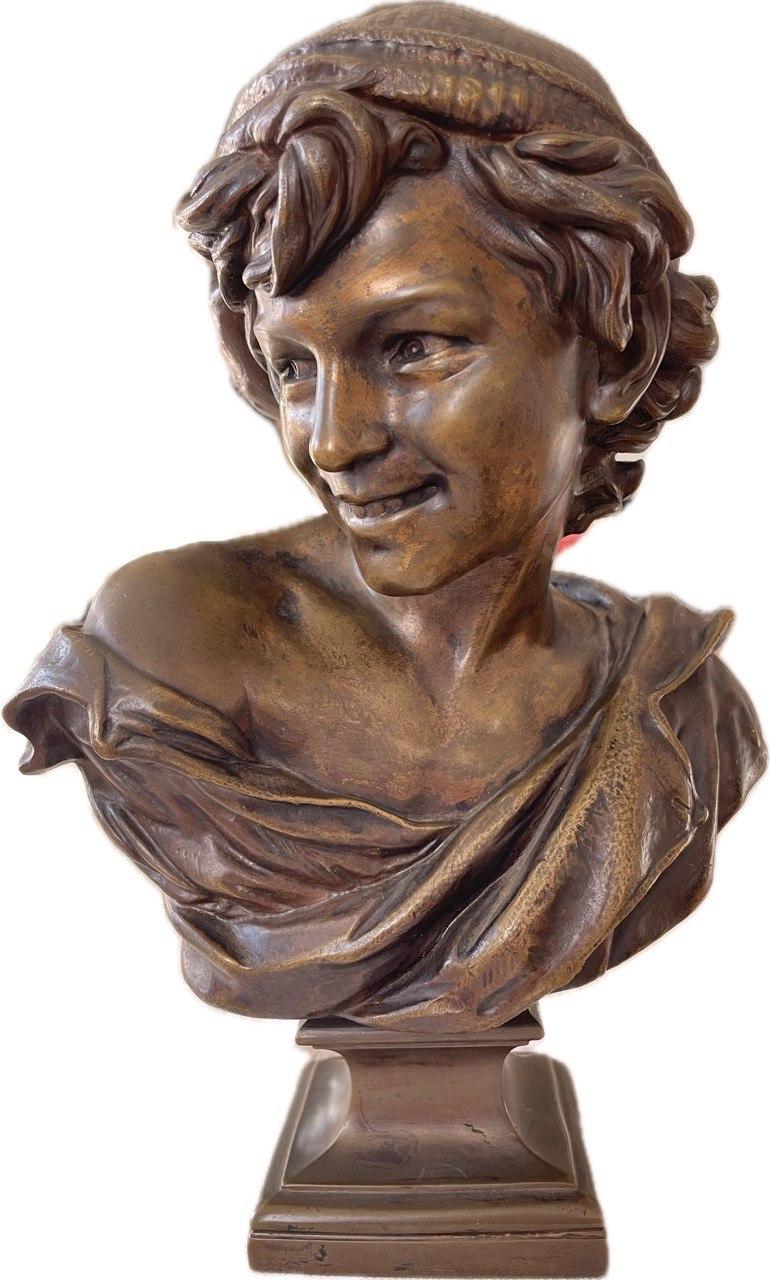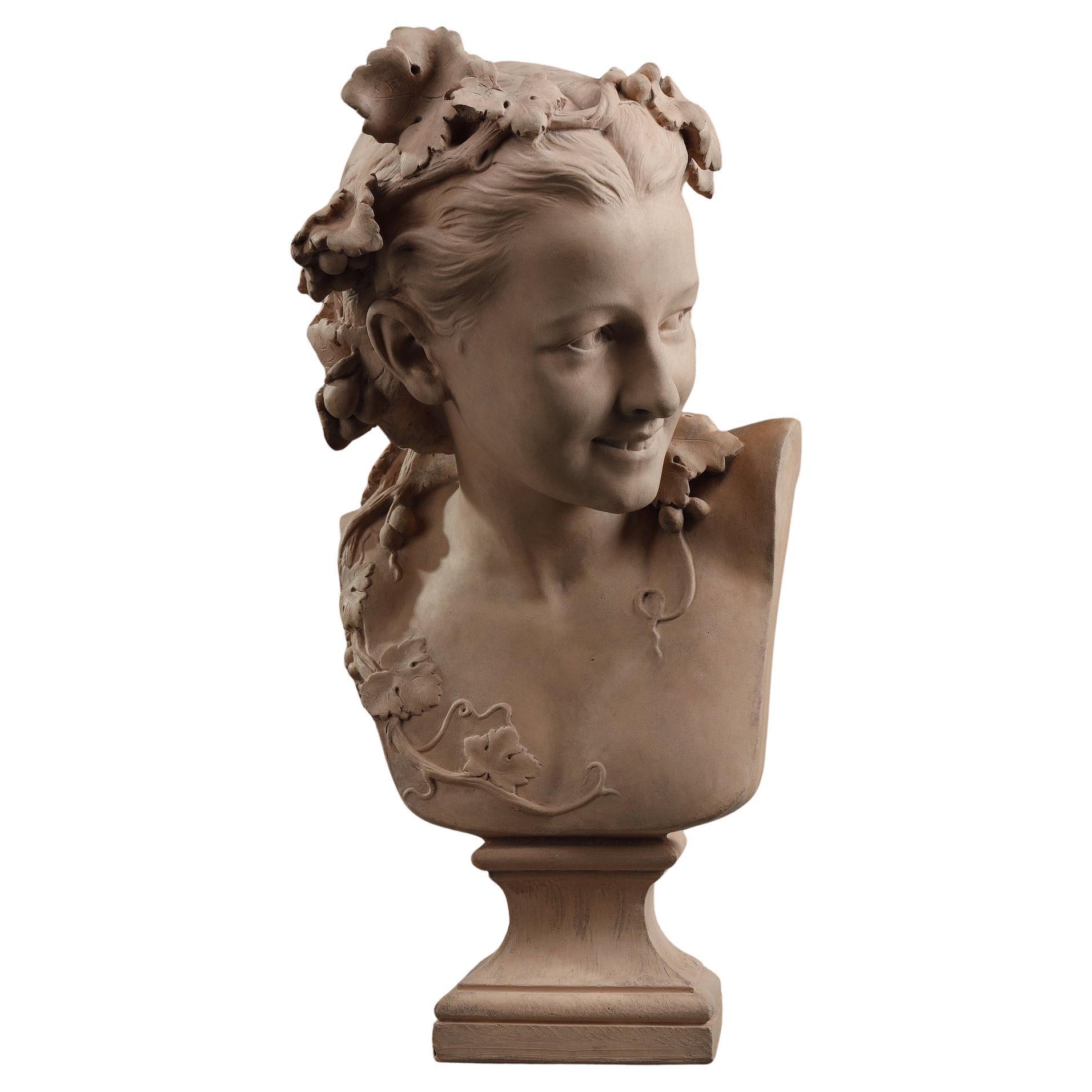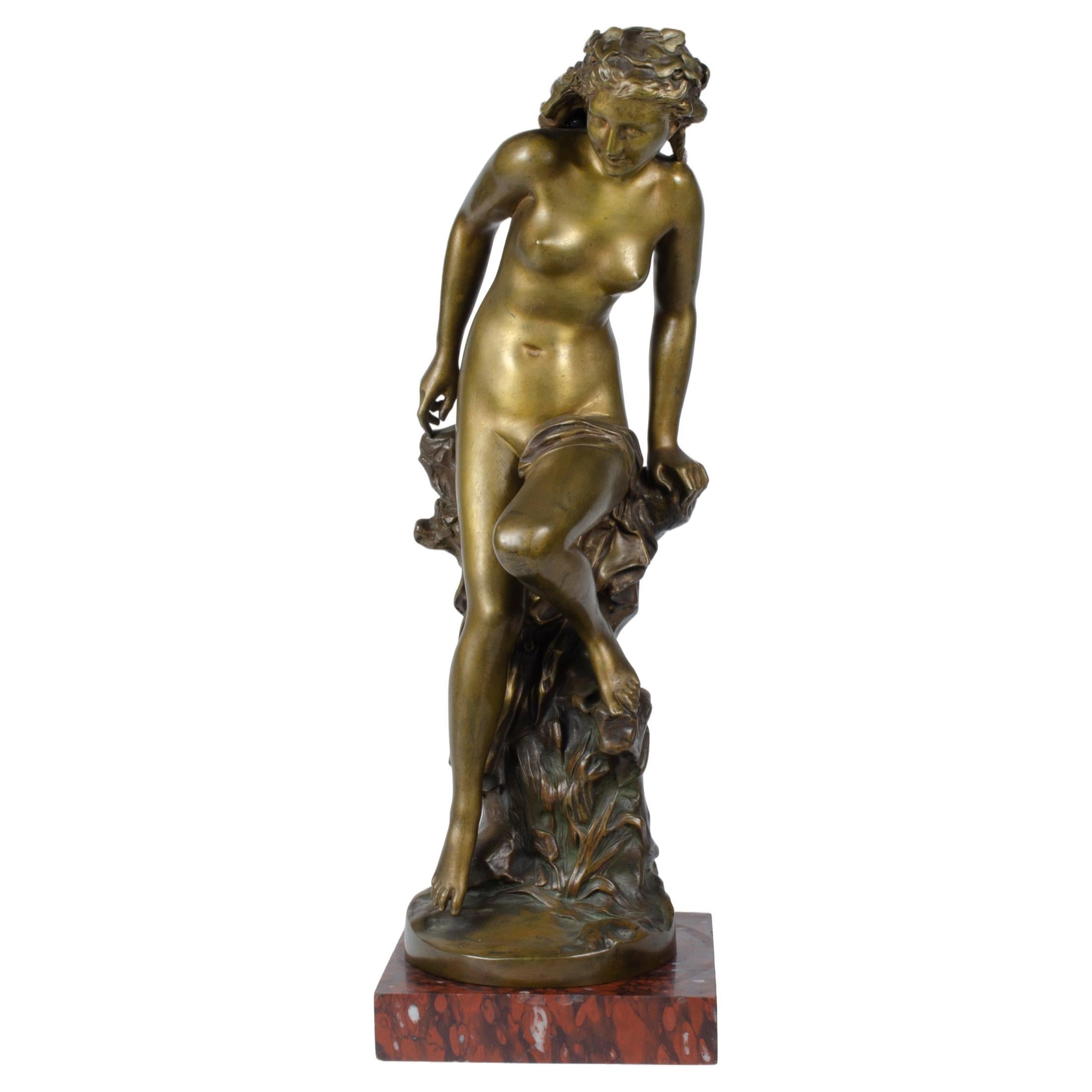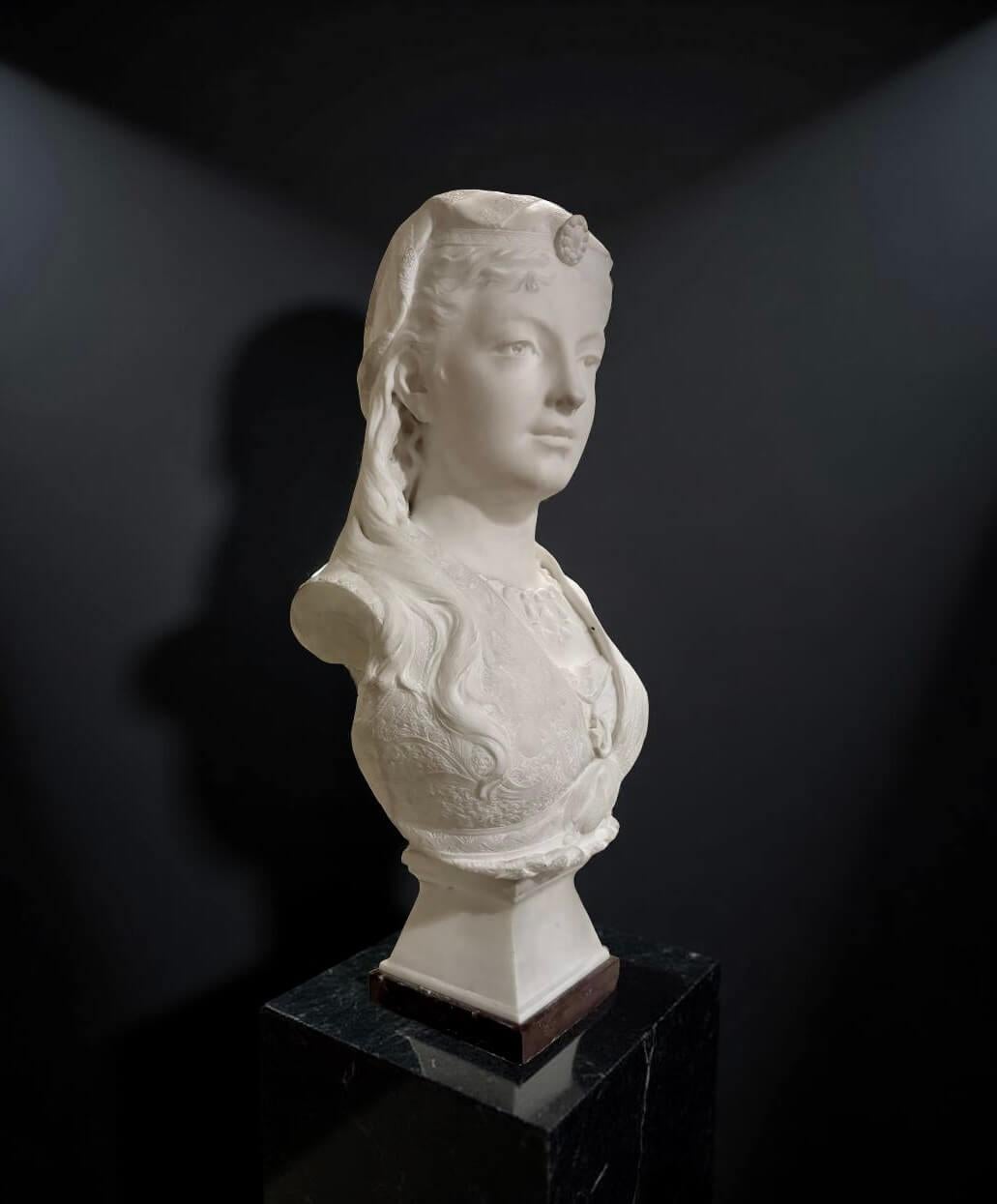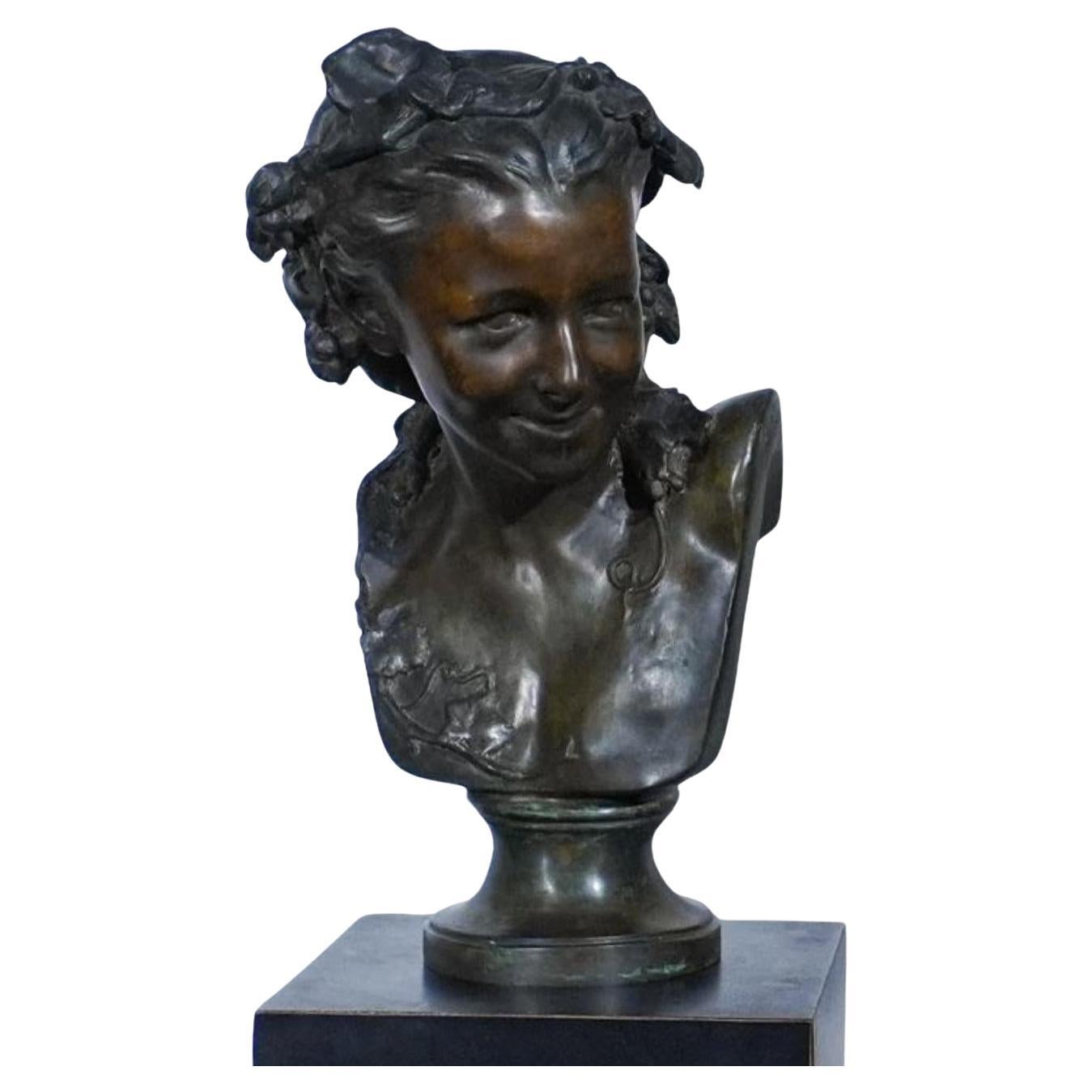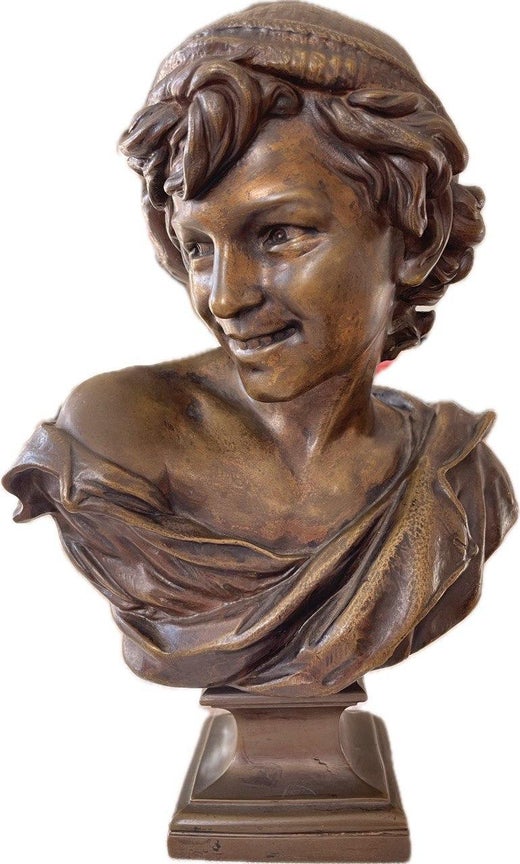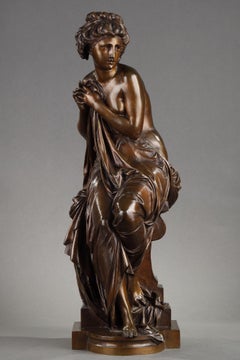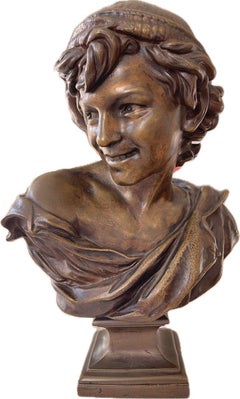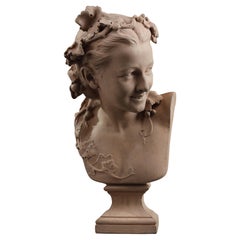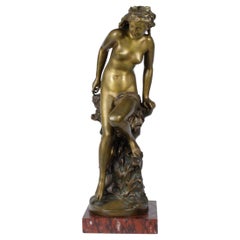Items Similar to La Rieuse napolitaine
Want more images or videos?
Request additional images or videos from the seller
1 of 16
Jean-Baptiste Carpeaux (1827-1875)La Rieuse napolitainecirca 1875
circa 1875
$10,314.68
£7,719.43
€8,700
CA$14,230
A$15,824.35
CHF 8,311.29
MX$193,468.59
NOK 103,566.68
SEK 97,635.40
DKK 66,228.72
About the Item
La Rieuse napolitaine
(The Laughing Neapolitan Woman)
by Jean-Baptiste CARPEAUX (1827-1875)
Bust in terra cotta, in "Propriété Carpeaux"
Signed on the side " JBte Carpeaux "
Marked with the stamp ‘Propriété Carpeaux’ with the Imperial Eagle mark.
Made during Carpeaux' lifetime or shortly after his death
France
circa 1875
height 49,5 cm
width 30 cm
A similar model is reproduced in « Jean-Baptiste Carpeaux sculpteur, catalogue raisonné de l’œuvre édité », Exposition du Musée des Beaux-Arts de Carcassonne, 2003, page 149.
Biography :
Jean-Baptiste Carpeaux (1827-1875) grew up in a modest family of workers in Valenciennes. He liked to draw and wanted to study sculpture against the will of his father. At the Academy of the city, he followed René Fache's sculpture classes and Bernard's architecture classes. Arrived in Paris in 1838 with his family, Carpeaux received a first training in drawing and modeling at the Little School. In 1844, he entered the School of Fine Arts in Paris in the studio of François Rude. Ten years later, he won the Prix de Rome. His arrival in the Italian capital was deferred for a year, the artist having to complete several orders. Carpeaux moved to the villa Medici in January 1856 and studied the great masters: Raphael, Michelangelo. He travelled to Italy where he drew his taste for movement and spontaneity. From his Italian stay, he sculpted three shipments, the Little Pouter, the Fisherman with the shell and his Ugolin surrounded by his four children.
In 1862, as he returned to Paris, Carpeaux was introduced to the imperial court by his friend and patron, Eugene Halwin Piennes, soon chamberlain of the Empress. He sculpted the same year a bust of Princess Mathilde whom allowed him to obtain several orders from the Emperor Napoleon III. But each of his works, in which his naturalist conceptions and his desire to recreate the movement inspired by the Baroque style, were the subject of controversy. Carpeaux took part in the exterior decoration of the Flore pavilion at the Louvre Palace (The Triumph of Flora, considered too sensual), and the opera newly built by Garnier, with a high relief La Danse, indignant to the public by his freedom and his realism.
He collaborated with the architect Gabriel Davioud for his latest work, the Fountain of the Four Parts of the World, also known as Fontaine de l'Observatoire in Paris. The last years of his life were dark. The war and the defeat of 1870 dried up the orders. At the same time, Carpeaux developed, with respect to his wife, an unhealthy jealousy that led to the separation of the couple in 1874. Under the influence of his parents, short of money, he abandoned the direction of his workshop to his brother. In 1875, he died at the age of forty-eight, after a terrible suffering due to bladder cancer. Jean-Baptiste Carpeaux, very attached to his hometown, bequeathed part of his works to the Museum of Fine Arts of Valenciennes.
- Creator:Jean-Baptiste Carpeaux (1827-1875) (1827 - 1875, French)
- Creation Year:circa 1875
- Dimensions:Height: 19.49 in (49.5 cm)Width: 11.82 in (30 cm)Depth: 11.82 in (30 cm)
- Medium:
- Movement & Style:
- Period:
- Condition:
- Gallery Location:PARIS, FR
- Reference Number:Seller: N.X1stDibs: LU2514214046622
Jean-Baptiste Carpeaux (11 May 1827 – 12 October 1875) was a French sculptor and painter during the Second Empire under Napoleon III. Life Born in Valenciennes, Nord, son of a mason, his early studies were under François Rude.Carpeaux entered the École des Beaux-Arts in 1844 and won the Prix de Rome in 1854, and moving to Rome to find inspiration, he there studied the works of Michelangelo, Donatello and Verrocchio. Staying in Rome from 1854 to 1861, he obtained a taste for movement and spontaneity, which he joined with the great principles of baroque art. Carpeaux sought real life subjects in the streets and broke with the classical tradition. Carpeaux debuted at the Salon in 1853 exhibiting La Soumission d'Abd-el-Kader al'Empereur, a bas-relief in plaster that did not attract much attention. Carpeaux was an admirer of Napoléon III and followed him from city to city during Napoléon's official trip through the north of France. After initially not making any contact with the emperor, he finally succeeded in arranging a face-to-face encounter at Amiens where he managed to convince Napoléon to commission a marble statue that was to be carried out by a practitioner, Charles Romain Capellaro. Carpeaux soon grew tired of academicism and became a wanderer on the streets of Rome. He spent free time admiring the frescoes of Michelangelo at the Sistine Chapel. Carpeaux said, "When an artist feels pale and cold, he runs to Michelangelo in order to warm himself, as with the rays of the sun". While a student in Rome, Carpeaux submitted a plaster version of Pêcheur napolitain à la coquille, the Neapolitan Fisherboy, to the French Academy. He carved the marble version several years later, showing it in the Salon exhibition of 1863. It was purchased for Napoleon III's empress, Eugénie. The statue of the young smiling boy was very popular, and Carpeaux created a number of reproductions and variations in marble and bronze. There is a copy, for instance, in the Samuel H. Kress Collection in the National Gallery of Art in Washington, D.C. Some years later, he carved the Girl with a Shell, a similar study. In 1861, he made a bust of Princess Mathilde, and this later brought him several commissions from Napoleon III. Then in 1866, he established his own atelier in order to reproduce and make work on a grander scale. In 1866, he was made chevalier of the Legion of Honour. He employed his brother as the sales manager and made a calculated effort to produce work that would appeal to a larger audience.[3] On 12 October 1875, he died at George Barbu Știrbei's château in Bécon-les-Bruyères, outside Courbevoie. Among his students were Jules Dalou, Jean-Louis Forain and the American sculptor Olin Levi Warner.
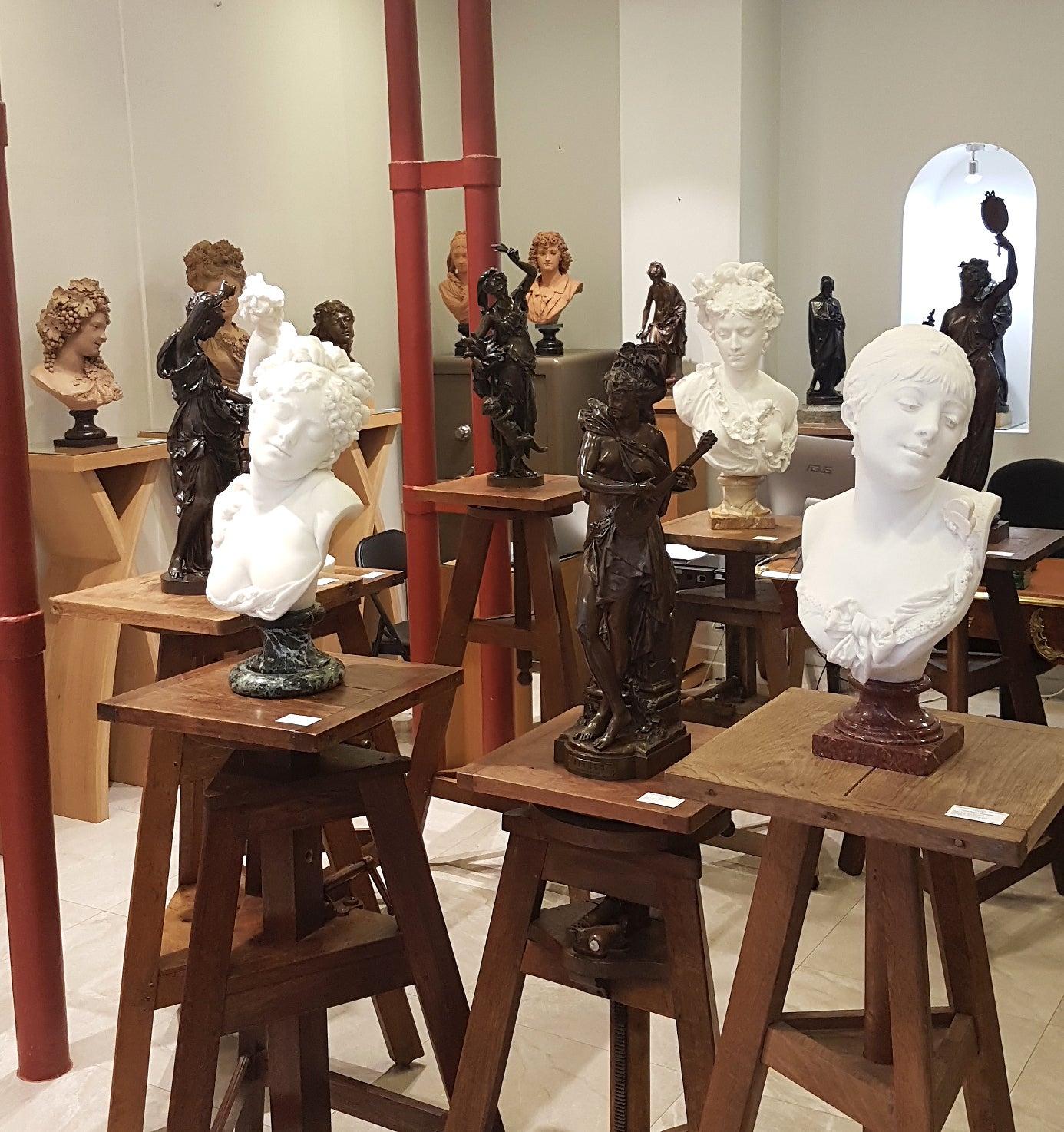
About the Seller
5.0
Recognized Seller
These prestigious sellers are industry leaders and represent the highest echelon for item quality and design.
Established in 1992
1stDibs seller since 2023
9 sales on 1stDibs
Typical response time: 1 to 2 days
- ShippingRetrieving quote...Shipping from: PARIS, France
- Return Policy
Authenticity Guarantee
In the unlikely event there’s an issue with an item’s authenticity, contact us within 1 year for a full refund. DetailsMoney-Back Guarantee
If your item is not as described, is damaged in transit, or does not arrive, contact us within 7 days for a full refund. Details24-Hour Cancellation
You have a 24-hour grace period in which to reconsider your purchase, with no questions asked.Vetted Professional Sellers
Our world-class sellers must adhere to strict standards for service and quality, maintaining the integrity of our listings.Price-Match Guarantee
If you find that a seller listed the same item for a lower price elsewhere, we’ll match it.Trusted Global Delivery
Our best-in-class carrier network provides specialized shipping options worldwide, including custom delivery.More From This Seller
View AllPortrait of a Lady
Located in PARIS, FR
Portrait of a Lady
by Charles CORDIER (1827-1905)
A rare bust in white Carrara marble
and onyx for the drape
Signed on the backside " C. Cordier "
Presented on a rounded white marbl...
Category
1860s French School Figurative Sculptures
Materials
Marble
Susanna
By Albert-Ernest Carrier-Belleuse
Located in PARIS, FR
Susanna
by Albert-Ernest Carrier-Belleuse (1824-1887)
Bronze sculpture with nuanced brown patina
signed to the side " A. Carrier "
old period cast
France
circa 1860
height 62 cm
...
Category
1860s French School Figurative Sculptures
Materials
Bronze
The Lily
Located in PARIS, FR
The Lily
by Auguste CLESINGER (1814-1883)
Outstanding bust sculpted in white Carrara marble
Signed on the ribbon " J. Clésinger, 1871 "
Presented on a rounded white marble base
France
1871
height 76,5 cm
width 48 cm
depth 35 cm
Noted in "Clésinger – Sa vie, ses œuvres - Le catalogue de ses œuvres", A. Estignard, Librairie H. Floury, Paris, 1900, p.169.
Biography :
Jean-Baptiste Auguste Clésinger, known as Auguste Clésinger (1814-1883), was a French romantic sculptor. His father, Georges-Philippe Clésinger, himself a sculptor, trained him at the School of Fine Arts in Besançon where he was a teacher. Auguste also studied sculpture under the direction of Bertel Thorwaldsen...
Category
1870s French School Nude Sculptures
Materials
Marble
Caress of Love
By Albert-Ernest Carrier-Belleuse
Located in PARIS, FR
"Caress of Love"
by Albert-Ernest CARRIER-BELLEUSE (1824-1887)
Bronze group sculpture with a nuanced dark brown patina
Signed on the back "A. Carrier-Belleuse"
Reposing on its orig...
Category
1870s French School Figurative Sculptures
Materials
Bronze
Young girl from Bou-Saada
By Louis Ernest Barrias
Located in PARIS, FR
Young girl from Bou-Saada
by Louis-Ernest BARRIAS (1841-1905)
Bronze sculpture with a nuanced dual patina
with blue enamelled jewels
Signed on the base " E. Barrias "
Cast by " Suss...
Category
Early 20th Century French School Figurative Sculptures
Materials
Bronze
Young girl from Bou-Saada
Located in PARIS, FR
Young girl from Bou-Saada
by Louis-Ernest BARRIAS (1841-1905)
Bronze sculpture with a nuanced dark brown patina
Signed on the base " E. Barrias "
Cast by " Susse Fres Edrs à Paris "...
Category
Early 20th Century French School Figurative Sculptures
Materials
Bronze
You May Also Like
"Le Rieur Napolitain" by Jean-Baptiste Carpeaux (1827–1875)
Located in Edinburgh, GB
A stunning bronze bust "Le Rieur Napolitain" by Jean-Baptiste Carpeaux (1827–1875), a master of 19th-century French sculpture. This piece captures the joyful expression of a young Neapolitan boy, reflecting Carpeaux’s signature realism and dynamic movement.
Details:
Artist: Jean-Baptiste Carpeaux
Title: Le Rieur Napolitain (The Laughing Neapolitan)
Material: Bronze
Dimensions: Height 27 cm, Width 19 cm, Depth 12 cm
Period: 19th century
Condition: Good, with a beautiful natural patina
Jean-Baptiste Carpeaux (1827–1875) was a leading French sculptor of the 19th century, known for his ability to infuse lifelike movement and emotional depth into his works. Le Rieur Napolitain (The Laughing Neapolitan) is a striking example of his dynamic and expressive style, embodying his fascination with naturalism and human vitality.
This bust is part of Carpeaux’s series of Neapolitan figures...
Category
Mid-19th Century Realist Figurative Sculptures
Materials
Bronze
Terracotta bust sculpture by Jean-Baptiste Carpeaux
By Jean-Baptiste Carpeaux
Located in Paris, FR
Terracotta bust of L'Espiègle or La Rieuse aux pampres de vignes signed in point JBt CARPEAUX Carpeau property stamp, eagle stamp, numbered 1801. This model, representing Anna Foucart, the eldest daughter of Jean-Baptiste Foucart, a faithful friend of the artist, was created in 1865. Carpeaux himself distributed it in his studio on rue Boileau in Auteuil from 1868, and his heirs continued to publish it.
Related bibliography: Michel Poletti and Alain Richarme, Jean Baptiste Carpeaux...
Category
Antique 1870s French Busts
Materials
Terracotta
Sculpture “La Frileuse” by Jean-Baptiste Carpeaux
By Jean-Baptiste Carpeaux
Located in Ciudad Autónoma Buenos Aires, C
Sculpture “La Frileuse” by Jean-Baptiste Carpeaux (1827-1875). It is made of gilded bronze supported on a red marble base. Signed JB Carpeaux, P B, Susse Frères, Editeuns Paris, Suss...
Category
Antique 1860s French Art Nouveau Figurative Sculptures
Materials
Marble, Bronze
Large Orientalist Bust in Marble of Armida French School 19th century Signed
Located in Pistoia, IT
Zacharie Rimbez (active between 19th and 20th centuries). White marble Orientalist bust depicting Armida, second half of the 19th century.
Armida is a Muslim sorceress, a charact...
Category
Late 19th Century French School Figurative Sculptures
Materials
Marble
Jean-Baptiste Carpeaux, L'Espiegle, Verdigris Bronze Bust Anna Foucart
By Jean-Baptiste Carpeaux
Located in Germantown, MD
Jean-Baptiste Carpeaux (French 1827-1975) L'Espiegle "The Mischief Maker" Patinated Verdigris Bronze Bust of Anna Foucart smiling.
Measures 10" wide , 10" deep and 19.5" tall.
Bor...
Category
Antique Late 19th Century French Neoclassical Busts
Materials
Bronze
Eugene Antoine Aizelin (French, 1821-1902) Patinated Bronze of Psyche
By Eugene-Antoine Aizelin
Located in New York, NY
This fabulous figural bronze statue of Psyche by the Barbedienne Foundry is simply exquisite. Remnants of a lovely green oxidation, nestled within the corners, curves and crevices of...
Category
19th Century Academic Figurative Sculptures
Materials
Bronze
More Ways To Browse
Fountain Woman
Imperial Eagle
Emperor Empress Art
Terra Cotta Bust
French Imperial Eagle
Jean Baptiste Carpeaux
Francois Rude
Terra Cotta Fountain
Terra Cotta Bust Of Woman
Danse De Flore
La Danse Carpeaux
Chrome Hearts Teddy
Dali St John Of The Cross
Erotica Vase
Erte Lovers And Idol
Femme Du Barbu
Folkert De Jong
Galos Spain
